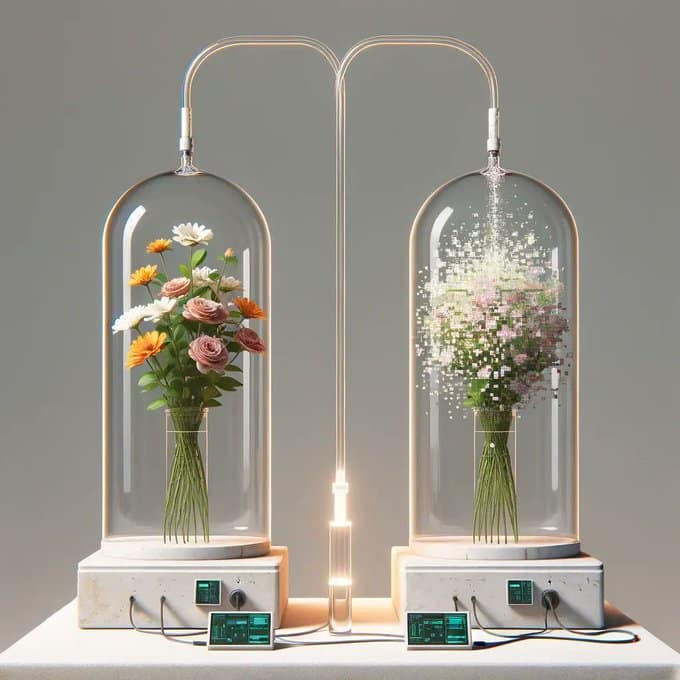The start-up Osmo has succeeded in developing an olfactory teleportation technology, which allows odours to be captured, digitised and reproduced at a distance. Marking a breakthrough in sensory communication and opening up new opportunities in areas such as virtual reality and the food industry.
Imagine being able to send the scent of a flower just picked during a walk to a friend on the other side of the planet, or accompanying a cooking video with the aroma of a freshly prepared dish. Sounds like science fiction? Not any more. Thanks to Osmo, a start-up from Cambridge, Massachusetts, this vision is becoming reality. With its innovative olfactory teleportation technology, Osmo is preparing to transform the way we live, perceive and share the world around us.

Olfactory teleportation: how does it work? (Video)
Osmo, led by neuroscientist Alex Wiltschko, has developed a system to remotely capture, digitise and reproduce odours. The process consists of three main steps:
- Odour capture: Using a gas chromatograph coupled with a mass spectrometer (GC/MS), the system analyses the aroma of an object, such as a fresh plum, identifying the odorous molecules that make it up.
- Digitisation: The molecular data is uploaded to a cloud platform, where an artificial intelligence model, called Principal Odor Map, transforms this information into a digital representation.
- Reproduction: A device, dubbed a ‘molecular printer’, uses a combination of chemicals to recreate the original aroma in liquid form, making the scent available for diffusion.
During testing (video), Osmo successfully completed the first olfactory teleportation using the smell of a plum. The CEO described this achievement as a milestone that opens the way to endless possibilities: ‘Well, we actually did it. We digitised scent. A fresh summer plum was the first fruit and scent to be fully digitalised and reprinted with no human intervention [it’s] a new starting line,’ Wiltschko stated on X. He also invites his followers to have the unique experience of smelling the first plum ever teleported, available directly on their website. Proceeds from this initiative will go to support scientific research, underlining the startup’s commitment to progress that combines innovation and sustainability.
Applications and future prospects
Osmo’s technology is not just a fascinating innovation, it has the potential to revolutionise numerous sectors through its creative and practical applications:
- Communication and social media: Imagine enriching a message, photo or video with the smell that best captures its essence. This technology could transform digital communication, adding a unique emotional layer that goes beyond images and sounds. Think of the impact of being able to send the aroma of coffee in the morning or the scent of a lavender field as a gesture of affection.
- Food industry and perfumery: With the ability to replicate and share authentic aromas, brands could offer customers a whole new experience when shopping online. Testing a fragrance or virtually tasting a dish before buying it could redefine e-commerce.
- Well-being and health: aromas profoundly influence our state of mind and well-being. Osmo’s technology could be used to create therapeutic olfactory experiences to relieve stress, improve concentration or even identify health problems based on specific sensory reactions.
The future prospects are limitless, from the integration of this technology into virtual reality visors to its use in educational, artistic or even personalised entertainment experiences. The world of Osmo encourages us to imagine a future in which smells are no longer confined to the time and place where we perceive them, but can be transmitted, stored and shared like any other form of communication.
A new Era for the senses
With its innovative vision, Osmo is redefining our relationship with the senses, bringing the often neglected sense of smell to the centre of technological communication. The prospects become even more intriguing when one considers the metaverse. Thanks to virtual reality visors and Osmo’s technology, digital worlds could become fully immersive spaces, allowing users not only to see and hear, but also to smell. Osmo is proving that innovation is not limited to sight and hearing, but also involves the deepest and most emotionally connected sense: smell.
This achievement is not just a technological advance, but a bridge to a future where emotions, memories and perceptions can be shared in ways never before imagined. Osmo’s olfactory teleportation is an open door to a new way of living and communicating, where the boundary between real and digital becomes an opportunity to connect in a more authentic and multisensory way.